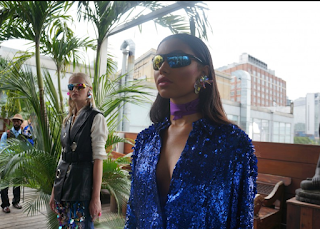The designer chatted about organizing his show, the must-have items of his collection and styling Beyoncé
Jerome LaMaar’s tagline for his 5:31 Jerome clothing line reads “Gratitude Is Glamorous,” and it’s evident as he is whisked off and enveloped in a bevy of kisses, hugs and screams of glee after his fashion show. Straddling the line between high-end basics and eclectic street wear, the young stylist is a favorite amongst celebrities, including Beyoncé, and his SS2016 “Maximalism” collection is an ode to all those embracing glamor, lush jewel-toned hues, layers and embellishments.
While embellishing is certainly one of his staples, the former senior designer of Baby Phat is also all about elegance, grace and mixing uptown with downtown to create the perfect blend of today’s woman. Attending his highly anticipated show on the first day of #NYFWSS16, EBONY caught up with fashion’s ‘It-Boy’ to discuss all things style, the must-have items and did we mention embellishments?!
EBONY: Explain the concept of your newest collection.
Jerome LaMaar: This season, I wanted to explore the multi-faceted world of MAXIMALISM!! I fused touches of the Amazon and disco dresses. After editing myself, I wanted to make sure every item was a bold statement piece.
EBONY: Showing at New York Fashion Week seems nerve-wracking. Give us some insight of what your world is like two weeks before the show.
JL: The countdown to the show is intense, but if you are organized, it's helpful. There are a lot of calls and follow-ups for items, locations, etc. I am usually looking at the details around that time.
EBONY: Who is the 5:31 Jerome woman?
JL: The 5:31 woman is playful, sexy, spiritual and bold. She is multi-faceted and complex but knows what she wants from every situation.
EBONY: You’ve been featured in major publications, and you’ve even appeared in your own Samsung commercial. With all of your success, where do you see the brand in five years?
JL: In five years, I would love to have a small boutique so I can work directly with clients and build strong wardrobes. I'd love to grow and work with real women at that point in my career.
EBONY: What are the must-have items from your new collection?
JL: From my SS16 capsule, everyone needs the eyelet leather jacket, the Zebra Velcro platforms, and most of all, the beaded tropical printed safari jacket.
EBONY: What advice would you give to up-and-coming designers of color?
JL: I would advise them to stay focused on their point of view, because you do need to compete when you stay in your own lane. Also, focus on making two things amazing and grow from there. Don't think in terms of collections. No one buys a full look. Think in terms of items and capsules.
EBONY: Who would be your dream celebrity to style and why?
JL: My dream celebrity is Beyoncé, although I have already dressed her. I think she is the symbol for strong women who are complex but know exactly what they want...and work HARD for it!
























